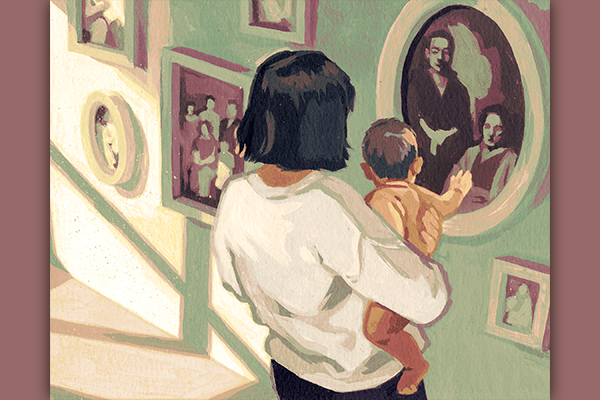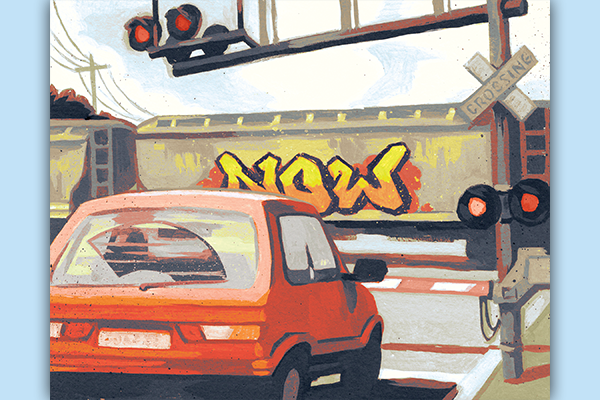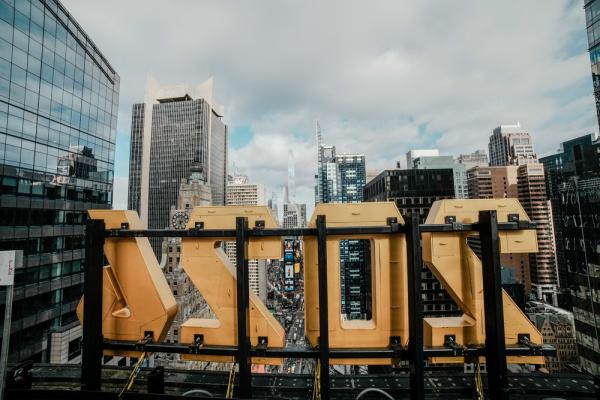This interview is part of The Reconstruct, a new weekly newsletter from Sojourners. In a world where so much needs to change, Mitchell Atencio and Josiah R. Daniels interview people who have faith in a new future and are working toward repair.
In the late summer heat of Washington, D.C., several new memorials appeared on the National Mall. But unlike many of the monuments in the nation’s capital, these were not monuments dedicated to presidents and war heroes.
These new memorials were part of Beyond Granite, a multi-project collaboration to answer the question: “What stories remain untold on the National Mall?”
Ashon T. Crawley, author, artist, and professor of religious studies and African American and African studies at the University of Virginia, constructed a memorial for Black church choir directors who died during the U.S. HIV/AIDS crisis. The exhibit, “HOMEGOING,” told the story of the musicians who, as he puts it, “died within a kind of epistemological moment,” where to be a musician in the Black church was to be understood as gay, to be gay was to be understood as HIV-positive, and vice versa.
At the memorial, which sat near the base of the Washington Monument, music, written and recorded by Crawley and others, played as attendees moved through three sections: blue platforms (“Procession”), a labyrinth (“Sanctuary”), and finally an arching semicircle (“Benediction”).
Crawley spoke with Sojourners’ associate news editor Mitchell Atencio about the music of the Black church, learning about fear from queer activists, and the value of memorials.
This interview has been edited for length and clarity.
Mitchell Atencio: What was the timeline for “HOMEGOING”?
Ashon T. Crawley: I got contacted by Monument Lab in Sept. 2022. They knew about my writing about the AIDS crisis and the Black church and the artistic practices I was experimenting with. I was doing a lot with sound, thinking about the AIDS crisis through sermonic content and musicianship.
It felt surreal then, it still feels surreal now, to be on the National Mall. It’s the most visited public space in the United States annually. When they contacted me, I immediately began to think about a way to honor musicians, singers, and choir directors. I thought about a project that would be able to honor, pay homage to, and be a ceremony that would allow for these musicians — in my theorizing and thinking — whose souls are not or were not at rest because of the refusal of speaking honestly about the complexity of their lives while they lived and when they died.
I was very pleased to be able to tell this story in a very prominent and national way, to make this story central to the story of America. Because the stories of erasure, the stories of the use of labor without the honoring of the laborer, is a deeply American story, insofar as the United States of America struggles with the exploitation of personhood in the service of building a political and economic order that — at the same time — is the degradation of the ones who are building the political and economic foundation from which that order can emerge. This felt like a deep part of that story, while also being very particular.
What was the process for making the music that accompanied the installation?
The sonic foundations for “Procession” and “Benediction” are co-written by JJJJJerome Ellis, who is a composer, artist, and poet. They’re based in Virginia, and we have mutual appreciation for each other’s work. I just contacted them on a whim to ask, “Would you be interested in doing something with strings that is low, meditative, and repetitious, that could create a kind of atmosphere of quietude, of surrender, and of joyful mourning?”
Jerome turned back both the [musical] foundations for “Procession” and for “Benediction.” On “Procession” and “Benediction,” I am playing the Hammond B-3 organ, which is this prominent instrument in American popular music: rock ‘n’ roll, blues, jazz, but certainly also in gospel music. It is my favorite instrument. The way you can sculpt your sound with it is so very inventive and special to me. And so, I am playing the Hammond organ on both those sections, improvising to try to create a sound that is both churchy but also one that you could hear on experimental electronic music.
In “Procession,” I am saying names of people who died of AIDS complications atop the music. Three hundred and five names are recited in total. And in the final section, “Benediction,” I am reading passages from The Lonely Letters, my second book, a book about loneliness, mysticism, Blackness, love, joy, heartbreak, and… quantum mechanics, because why not?
“Sanctuary” [the middle section] has four songs that were written for a choir. I wrote both the lyrical content and the music for each of the songs.
I took two songs from three musicians each, six songs in total. These three musicians each died of AIDS complications by 1995. I dumped the lyrics of these six songs into a unique word finder, and then found words that resonated with me and took those words as the foundation for the four songs. So, their lyrical content is referenced, but their lyrical content is not what is being sung. I also took a lot of the chord changes, progressions, and harmonic patterns that these three musicians would use in their music as the foundation for the music that I would create.
The four songs that are in that section were performed by a choir that I call the HOMEGOING Ensemble — 12 singers. Producer Clifton Ross III was able to gather the 12 singers who took the lyrics and made it sound good.
I also worked with a musician who I’ve worked with on several projects now, Abdul Hamid Robinson-Royal. He provided the music for the Hammond organ for the choir section. And he also played the Hammond organ for the live concert on Sept. 9.
I’ve wondered about the responsibility of honoring and memorializing people who may not have been fully out, or people who were “closeted.” What does it mean to honor them without being anachronistic about the labels they may have used or not used?
It’s a very difficult ethical dilemma. For this project, I’m answering it differently than I do in my book. In the book, I’m writing about the AIDS crisis in the Black church, I’m actually using names of musicians who died of AIDS complications, largely because the same epistemology of shame and fear regarding the AIDS crisis still exists. It feels important within that context to name people — not to out them — because, according to a theological position that a lot of people have, AIDS is a sign and a symbol for a series of failures.
Even if a person did not die of AIDS complications, they are captured in the conversation of AIDS because of the time period in which they died. If they were a choir director and they died, it didn’t matter if they were gay or not. It didn’t matter if they were HIV-positive or not. What matters is that they died within a kind of epistemological moment, and that moment means AIDS … to do music in that way, at that particular moment in world history, was to be coded as queer and to be coded as living with a disease.
But I answer that question totally differently for “HOMEGOING.” For this installation, it felt very important to protect names, because I was trying to create a certain kind of intimacy with the music and with the people who have died. Which meant, on the one hand, “Procession” names people, but just the first name, or the first and middle name. It’s not the first and last name of a person.
It felt important to raise names up, to lift them up in their particularity. But it also felt very important to engage in a kind of intimacy and care that says, though this music is created with three very specific musicians [in mind], their music was created not because of them in their individuality, but because of a social practice of music making. And that social practice of music making was one that they participated in, extended, and that they also were produced by.
In both [“HOMEGOING” and my book], what I’m trying to do is practice intentional care and refuse sensationalizing the AIDS crisis.
At the beginning of the pandemic, you wrote to your students and said, “I need the reminder [that fear is] not something to shun but an emotion to honor, like any other emotion. … [it is] sacred because the emotion betrays to us something about our desires and our hopes, it reminds us that we are indeed alive and not numb to it all.”
How has your study of the AIDS crisis, and particularly queer activists in that era, influenced how you understand fear?
They confronted fear, right? They didn’t act like fear was not real. They didn’t act like fear wasn’t something we experience as human creatures who don’t know everything. There’s something about uncertainty that is a part of the deeply, creaturely human experience. Instead of trying to pretend that we can live fearlessly, what I learned from them is that fear is something to recognize and notice, and to honor the fact that fear is real, but you don’t have to get stuck in fear.
Fear does not have to mean a refusal to move or stasis. Fear can be felt alongside and through the practice of movement, the practice of resistance, the practice of reckoning, and the practice of honoring.
AIDS quilts are a primary example of what it means to sit with — honor — fear and to still engage in the practice of remembrance. ACT UP, with all of the political organizing, recognizes that we have to actually practice care for people. We can be afraid or fearful of a sort of biological fact of a disease or virus, but that should not compel us to not engage in caring relationships with one another.
Instead of pretending that we don’t have fear, if we honor it, perhaps we can engage in more just and ethical practices with one another. … One of the primary ways that I sit with fear is by sitting in community with others, by presuming that fear is not a thing that has to be felt at the individual level alone, but that fear can be a social practice.
For me, the cultivation of relationships is the primary thing that I try to do on a daily basis. I’m really intentional about talking to my friends all of the time. I have one friend that I talk to on the phone just about every day. I also text other friends all of the time. I email friends. I’m constantly in conversation with people who care about me as a person, and I care about them as people.
I noticed that the album for “HOMEGOING” is coded on streaming services as “Christian” music, was there a specific intention behind that?
No, I feel awful about that. Honestly, I wish that there was a genre that the album makes sense in. It sounds like gospel music, so I selected Christian because it was the closest thing sonically to the way that it sounds. “Experimental” music didn’t get at the kind of precision with the sonic practices. R&B, funk, soul — none of those things are correct. I couldn’t find a category for the streaming services that was “sacred,” or “death music,” so it’s just the closest to what it sounds like.
But that has its own problems because then people say, “Oh, this is gospel.” It is, but the songs are written to and about the musicians. They’re not written to God or about God at all — intentionally.
There is some sense in which it felt descriptively about Christians. I understand it’s not to God or about God, but I was thinking about Semler and other queer artists who are very intentional about it being a protest to say their music still fits the “Christian” category.
Yeah, I’m not though. I no longer identify as Christian. I understand the kind of work that it could be doing by saying that this is Christian music, but for me, the intention wasn’t to do that kind of resistance work as much as there is no category, sonically, that I think that this album fits within as closely as something like Christian or gospel. I chose it for that reason alone.
You were a pastor and specifically worked as a prison chaplain for a time. What did you learn from that work?
What I learned was the thing I wasn’t supposed to learn: Prison is literally awful and should not exist.
I became a proto-abolitionist while being a chaplain at Metro State Prison for Women, because it felt genuinely awful to be tasked with going into a carceral space weekly to lead a church service. It felt unethical. It felt unjust to have these weekly church services where we were, as student chaplains, in charge and told to preach sermons. And then we could leave after an hour and a half.
We would have a weekly reflection with the chaplain who worked at the prison as her full-time job. So, my grade is tied to the carceral space, and my ability to say I’ve grown spiritually is predicated on people being unable to leave. What did it mean to preach about liberation or freedom from within that context?
It was the first time that I began to really think that not only is the work we’re doing as chaplains untenable, but it also feels untenable to enter this space at all, because the space should not exist. This was before I’d read Angela Davis, Ruth Wilson Gilmore, or before I knew groups like Critical Resistance existed.
You were talking about this exhibit being a part of the story of labor in the U.S. Is that connection about how the church used the labor of queer musicians to build its own sort of power, both political and social?
That’s precisely how I meant it. Churches need good music departments. They need musicians who can move the congregation. They need choir directors who can be charismatic. They need singers who sing well. And often, not as a biological fact, the artistic practices allow for a kind of flexibility in terms of queer presentation or queer potential. For some reason, music is a place where people imagine queerness operating.
It’s within that context that a lot of these musicians, singers, and choir directors are doing the work that they do. There is a way that queerness is accepted within this kind of space. But success in this work is then used to exploit them: These musicians, singers, and choir directors are told to never speak their secrets, speak their secrets only if they are repenting for them, or lie about them.
On the one hand, you need this kind of queer potential, which shows up as a musical practice. At the same time, the doctrinal and theological orientations are dismissive of and discarding the very queer potential that makes the social practice possible.
Subscribe to The Reconstruct for more from Crawley, as well as photos of “HOMEGOING.”
Got something to say about what you're reading? We value your feedback!







